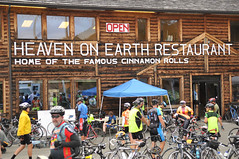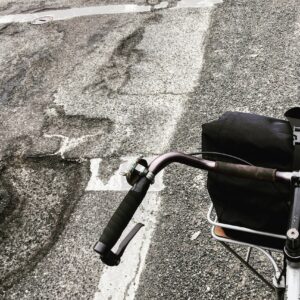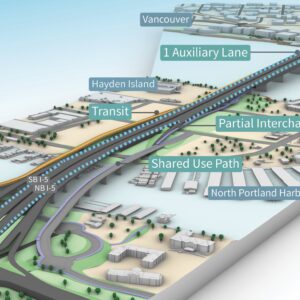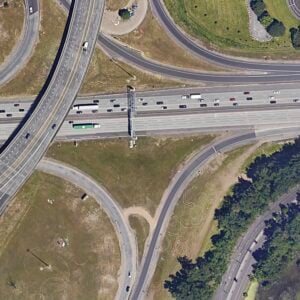Portland and Oregon’s bike economy has gotten a lot of play in the media and in advocacy circles, but the size of our bike economy is peanuts compared to Wisconsin’s. According to a study released today by the University of Wisconsin-Madison, bike-related tourism and industry pumps $1.5 billion to that state’s economy each year.
“Recreational bicycling” had the largest impact, accounting for $924 million. Of that amount, the study says, $533 million is direct spending and $391 million is due to “indirect and induced effects, such as increased purchases of supplies and labor by restaurants and hotels serving cyclists.”
But wait, there’s more:
- Bicycling creates 13,000 Wisconsin jobs
- Bicycling has a larger economic impact than deer hunting ($926 million) and snowmobiling ($250 million) combined.
- 49% of Wisconsinites participate in recreational biking
- A 20% increase in biking could increase economic activity by $107 million and create 1500 more jobs
The study went way beyond just crunching numbers. It also looked at bicycling’s impact on health care costs and it offered policy recommendations to increase bicycling.
“The report’s authors also calculated the potential economic value of increased bicycling as a replacement for short automobile trips. They estimated that improvements in air quality and the health of Wisconsin adults could yield annual savings valued at more than $400 million.”
These are impressive numbers and this report will be a powerful tool for advocates and pro-bike politicians in Wisconsin.
Here in Oregon, we’ve got all the pieces in place to have a bike economy that rivals Wisconsin’s. We may not have major companies like Trek, Saris, and Planet Bike, but we’ve got plenty of small, up-and-coming, and medium-sized bike businesses that are poised for growth. We also have strong support for bicycle tourism — evidenced most recently by the Ride Oregon website created through a partnership with Travel Oregon.
A report issued in September 2008 by Alta Planning valued Portland’s bike-related economy at $90 million and accounting for 1,150 jobs.
What Oregon needs is a study to capture all the bike-related economic activity across our entire state. In Portland, Eugene, and other bike hotbeds, we need more attention from elected officials to help nurture and subsidize bicycle industry innovation and development.
Download, Valuing Bicycling’s Economic and Health Impacts in Wisconsin, at the Bicycle Federation of Wisconsin’s website.







Thanks for reading.
BikePortland has served this community with independent community journalism since 2005. We rely on subscriptions from readers like you to survive. Your financial support is vital in keeping this valuable resource alive and well.
Please subscribe today to strengthen and expand our work.
Saw that HEAVEN ON EARTH photo, and remembered all the great service from them during CO’09.
Can’t recommend that place enough. AWESOME!
Now, if I could only find a way of doing more $$ for bikes myself, so I could go there more often. 😉
LET’S GO PACK!!
This article is incredible. We can do a lot better than a state with high humidity, bugs and tornados. Cycle Oregon should just be the tip of the iceberg. The only advantage the cheese heads have over us are larger population centers that can more easily drive to the state.
Contrary to what Portlanders may believe, Portland, OR isn’t the cycling center of the universe. People in other states DO ride, and ride a lot. They just don’t stand up and beat their chests about it like Portlanders do. I’ve ridden in Wisconsin and Minnesota (and even Louisiana) and I’ve enjoyed riding in those states just as much as here in Oregon.
While I applaud the Bike Federation of Wisconsin (former member) for all their recent urban development efforts, but living in Wisconsin for 25 years I have a different opinion than these numbers suggest.
“49% of Wisconsinites participate in recreational biking”
I have no idea whom/where they polled for this number.
and nothing is bigger than deer hunting.
Did’ya see da 30 pointer?
Don’t forget Pacific Bicycle another big player in Wisconsin (Schwinn, Cannondale, GT, Mongoose).
Not hard to see how the numbers climb when you have some of the biggest bike companies in the world reporting their sales numbers in the state of Wisconsin.
And having lived in Wisconsin, I have to laugh at the health claims. Some of the highest rates of smoking and drinking in the country.
Wisconsin has a long history of dairy farming and,
as a consequence,has an extensive system of well paved roads. Since milk must be delivered to The
dairies every day ,rain,shine or snow;the roads
must be open always. Cyclists here enjoy what may
be the best town roads and county highways in
America. And we owe it all to our cows,creatures
held in great esteem and deep respect here.
“49% of Wisconsinites participate in recreational biking”
Yeah anyone with a bike in their garage that rides once or twice a year… no doubt.
The biggest contributors to the Wisconsin economy are probably the bike builders like Trek. Although the report does seem to indicate that Bike Tourism is the big item… interesting.
I’m not buying the 49% number, but I don’t doubt some of their other numbers.
SW Wisconsin has some of the best cycling in the area. There is a reason the Chicago Olympic committee chose that area (200+ miles away) for the Olympic road race. The terrain is challenging and the scenery beautiful.
I, personally, am glad to see cycling getting pushed to the forefront and in the news in a positive way.
Iowa (just below and to the left of Wi, for those of you midwesternly impaired) Also has RAGBRAI, which contributes hundreds of thousands of dollars to the economy each year. Towns have built hospitals and parks off the revue, and often their entire yearly income is doubled in one day of RAGBRAI passing through their town. It’s a ride with over 10,000 bikers.
As a result Iowa is pretty good for cycling (ranked 6th by the LAB), and Wisconsin’s BRAN is based off the ride, but much smaller.
People are nicer to cyclists when they can thank them for their tiny towns new ambulance.
Yes, that “recreational biking” is probably including people who ride 1-5 times a year. On the other hand, Sagbraw and Grabaawr and Best Dam Bike Tour and Chequamegon Fat tire Fest, and the WORS series and . . .and . . . well, let’s say there are a lot of events for those who bike. The midwesterners are more likely to be a ‘joiner’ then anyone out west – these events consistently draw thousands. There is one hellova rails-to-trails system in that state, and it’s used for commuting or tourism – and the state is flat enough that you don’t have to be in good shape to ride.
But @7, the bit about the roads being clear? A milk truck has an engine and a heated cab. There’s always some idjit riding in the winter in the cities, but the slushy rural roads are bike free for 4-6 months a year.
-former BFW boardmember
Hi Jonathan! I will say after living here a half year that recreational cycling here in Wisconsin really is excellent: lots of good rural roads, lots of dedicated cyclists, and a lot of good organized rides.
However, Portland is in a very different place when it comes to bike commuting. Madison and Milwaukee are more like Eugene or San Francisco: lots of arterial roads with fast traffic, lots of unaware and aggressive drivers, and a real lack of bike parking. Add the winter weather (and constantly cleaning off the road salt, ugh!) and bike commuting becomes a decidedly not-normal thing to do regularly.
They’re very good about ploughing and salting the trail system, so we’re far from ignored. But the systems to help people get from point A to B by bike are just not in place here…yet, anyways. I sense that the Wisconsin Bike Fed is taking the first (!) steps trying very hard to get people used to the idea of biking on city streets; last summer’s Sunday Parkways equivalent (Ride the Drive, which goes makes a loop on Hwy 151) surpassed everyone’s expectations.
I have to imagine this includes the impacts from Trek bikes being based there.
1.5 billion?
I think U of WM has been studying crack
maybe they are including Trek’s gross or net income in that figure????
The report used a previous estimate of $593,787,990 for the industry impact – Trek, Saris, Planet Bike etc. That came from a previous report from the Bicycle Federation of Wisconsin and was adjusted for inflation.
That $924 million figure for riders spending related to touring and recreation relies on a big estimate of indirect and induced money. The firmer figure is $532.9 million in direct spending in restaurants, hotels etc.
Actually, the RAGBRAI number is $24 million of direct spending.
“we need more attention from elected officials to help nurture and subsidize bicycle industry innovation and development.”
Well, the last time we had our US Congressman Blumenauer pay any attention to mountain biking out by Mt Hood, he decided it was BEST to CLOSE 110+ miles of ‘some of the best singletrack in the universe’. These were trails mountain bikers rode AND maintained for over 2 DECADES. So much for elected officials helping the economy of Hood River County!
@Shawn Small – did we work at Project Crew together?
I am proud to work for the Bicycle Federation of Wisconsin. And it is often underated on many cycling issues because there are more things people often associate with WI, i.e. packers, hunting, cheese, beer.
“49% of Wisconsinites participate in recreational biking”
Shawn Small said:
“I have no idea whom/where they polled for this number.
and nothing is bigger than deer hunting.”
That number came from Wisconsin’s State Comprehensive Outdoor Recreation Plan, specifically :
Wisconsin Statewide Comprehensive Outdoor Recreational
Plan, Wisconsin Department of Natural Resources, 1999,
Table 3 of Supplemental Index B-1, p 18.
And, yes bicycling is bigger in this state than deer hunting, as shown in the current WI SCORP:
which shows “Mountain Biking (off-road)” as having 20.4% of state residents participating, as well as “Mountain Biking (single-track)” with 18% of state residents participating, versus “Hunting – big game” having a 19.2% participation rate by state residents. And they didn’t even count cyclists who ride on the paved roads in table B-2 on page B-8 of this:
http://www.ncwrpc.org/wood/wr_orp/Att%20B_SCORP_WR.pdf